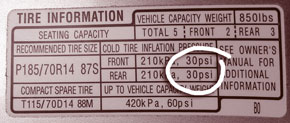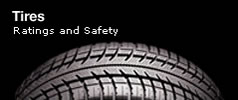|
Tire Pressure & Loading
Tire Ratings-UTQGS
Tire Labeling
Other
Tire FAQs
|
|
Tire Safety
Help Us Promote Tire Safety Underinflated tires and overloaded vehicles are the leading causes of tire failure. If you or your organization would like to help NHTSA promote the “What’s Your PSI?” tire safety campaign and its key messages, email us today or call 202-366-9550. Together we can help everyone stay safer on our nation’s roadways. 
Brochure
Key Tire Care Messages - All motorists need to check their tire pressure at least once per month.
- You can’t tell correct tire pressure just by looking. Use an accurate tire pressure gauge to measure pressure when tires are “cold” — meaning they haven’t been driven on for at least three hours.
| | | Tire at 32 psi
(100% recommended pressure) | Tire at 16 psi
(50% recommended pressure) | - The correct PSI or pressure for your tires is listed on your vehicle’s tire information label or in your owner’s manual, not what's on the side of the tire.

- Check the overall condition of your tires, particularly the tread and sidewalls, at least once a month.
- Use the Lincoln’s head penny test, or look for the built-in wear bar indicators to determine when it’s time to replace your tires.
- Make note of any irregular tread wear. This could be an indication of a wheel misalignment, the need for a tire rotation, or both. Uneven tread wear is a sign that you need to take your car in for servicing.
|










